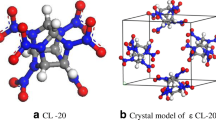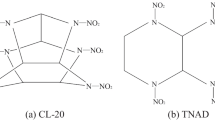Abstract
“Perfect” and defective models of CL-20/TNT cocrystal explosive were established. Molecular dynamics methods were introduced to determine the structures and predict the comprehensive performances, including stabilities, sensitivity, energy density and mechanical properties, of the different models. The influences of crystal defects on the properties of these explosives were investigated and evaluated. The results show that, compared with the “perfect” model, the rigidity and toughness of defective models are decreased, while the ductility, tenacity and plastic properties are enhanced. The binding energies, interaction energy of the trigger bond, and the cohesive energy density of defective crystals declined, thus implying that stabilities are weakened, the explosive molecule is activated, trigger bond strength is diminished and safety is worsened. Detonation performance showed that, owing to the influence of crystal defects, the density is lessened, detonation pressure and detonation velocity are also declined, i.e., the power of defective explosive is decreased. In a word, the crystal defects may have a favorable effect on the mechanical properties, but have a disadvantageous influence on sensitivity, stability and energy density of CL-20/TNT cocrystal explosive. The results could provide theoretical guidance and practical instructions to estimate the properties of defective crystal models.













Similar content being viewed by others
References
Agrawal JP (1998) Recent trends in high-energy materials. Prog Energy Combust Sci 24:1–30
Sikder AK, Sikder N (2004) A review of advanced high performance, insensitive and thermally stable energetic materials emerging for military and space applications. J Hazard Mater 112:1–15
Lara OF, Espinosa PG (2007) Cocrystals definitions. Supramol Chem 19:553–557
Shan N, Zaworotko MJ (2008) The role of cocrystals in pharmaceutical science. Drug Discov Today 13:440–446
Liu K, Zhang G, Luan JY, Chen ZQ, Su PF, Shu YJ (2016) Crystal structure, spectrum character and explosive property of a new cocrystal CL-20/DNT. J Mol Struct 110:91–96
Xu HF, Duan XH, Li HZ, Pei CH (2015) A novel high-energetic and good-sensitive cocrystal composed of CL-20 and TATB by a rapid solvent/non-solvent method. RSC Adv 5:95764–95770
Bolton O, Simke LR, Pagoria PF, Matzger AJ (2012) High power explosive with good sensitivity: a 2:1 cocrystal of CL-20:HMX. Cryst Growth Des 12:4311–4314
Wang YP, Yang ZW, Li HZ, Zhou XQ, Zhang Q, Wang JH, Liu YC (2014) A novel cocrystal explosive of HNIW with good comprehensive properties. Propellants Explos Pyrotech 39:590–596
Yang ZW, Li HZ, Zhou XQ, Zhang CY, Huang H, Li JS, Nie FD (2012) Characterization and properties of a novel energetic-energetic cocrystal explosive composed of HNIW and BTF. Cryst Growth Des 12:5155–5158
Guo CY, Zhang HB, Wang XC, Xu JJ, Liu Y, Liu XF, Huang H, Sun J (2013) Crystal structure and explosive performance of a new CL-20/caprolactam cocrystal. J Mol Struct 1048:267–273
Chen PY, Zhang L, Zhu SG, Cheng GB (2015) Intermolecular interactions, thermodynamic properties, crystal structure, and detonation performance of CL-20/TEX cocrystal explosive. Can J Chem 93:632–638
Yang ZW, Wang YP, Zhou JH, Li HZ, Huang H, Nie FD (2014) Preparation and performance of a BTF/DNB cocrystal explosive. Propellants Explos Pyrotech 39:9–13
Zhang HB, Guo CY, Wang XC, Xu JJ, He X, Liu Y, Liu XF, Huang H, Sun J (2013) Five energetic cocrystals of BTF by intermolecular hydrogen bond and π-stacking interactions. Cryst Growth Des 13:679–687
Ma Y, Hao SL, Li HZ, Liu YC, Yang ZW (2015) Preparation and performance of BTF-DNAN cocrystal explosive. Chin J Energ Mater 23:1228–1230
Wei CX, Huang H, Duan XH, Pei CH (2011) Structures and properties prediction of HMX/TATB co-crystal. Propellants Explos Pyrotech 36:416–423
Lin H, Zhu SG, Li HZ, Peng XH (2013) Structure and detonation performance of a novel HMX/LLM-105 cocrystal explosive. J Phys Org Chem 26:898–907
Li HQ, An CW, Guo WJ, Geng XH, Wang JY, Xu WZ (2015) Preparation and performance of nano HMX/TNT cocrystals. Propellants Explos Pyrotech 40:652–658
Shen JP, Duan XH, Luo QP, Zhou Y, Bao QL, Ma YJ, Pei CH (2011) Preparation and characterization of a novel cocrystal explosive. Cryst Growth Des 11:1759–1765
Lin H, Zhu SG, Zhang L, Peng XH, Li HZ (2013) Synthesis and first principles investigation of HMX/NMP cocrystal explosive. J Energ Mater 31:261–272
Lin H, Chen JF, Zhu SG, Li HZ, Huang Y (2017) Synthesis, characterization, detonation performance, and DFT calculation of HMX/PNO cocrystal explosive. J Energ Mater 35:95–108
Landenberger KB, Bolton O, Matzger AJ (2013) Two isostructural explosive cocrystals with significantly different thermodynamic stabilities. Angew Chem Int Ed 52:6468–6471
Landenberger KB, Bolton O, Matzger AJ (2015) Energetic-energetic cocrystals of diacetone diperoxide (DADP): dramatic and divergent sensitivity modifications via cocrystallization. J Am Chem Soc 137:5074–5079
Lin H, Zhu SG, Zhang L, Peng XH, Chen PY, Li HZ (2013) Intermolecular interactions, thermodynamic properties, crystal structure, and detonation performance of HMX/NTO cocrystal explosive. Int J Quantum Chem 113:1591–1599
Wu JT, Zhang JG, Li T, Li ZM, Zhang TL (2015) A novel cocrystal explosive NTO/TZTN with good comprehensive properties. RSC Adv 5:28354–28359
Guo CY, Zhang HB, Wang XC, Liu XF, Sun J (2013) Study on a novel energetic cocrystal of TNT/TNB. J Mater Sci 48:1351–1357
Landenberger KB, Matzger AJ (2010) Cocrystal engineering of prototype energetic material: supramolecular chemistry of 2,4,6-trinitrotoluene. Cryst Growth Des 10:5341–5347
Ma Y, Huang Q, Li HZ, Tan BS, Liu YC, Yang ZW (2017) Preparation and characterization of TNT/TNCB cocrystal explosive. Chin J Energ Mater 25:86–88
Bolton O, Matzger AJ (2011) Improved stability and smart-material functionality realized in an energetic cocrystal. Angew Chem Int Ed 50:8960–8963
Yang ZW, Li HZ, Huang H, Zhou XQ, Li JS, Nie FD (2013) Preparation and performance of a HNIW/TNT cocrystal explosive. Propellants Explos Pyrotech 38:495–501
Xu XJ, Xiao JJ, Huang H, Li JS, Xiao HM (2010) Molecular dynamic simulations on the structures and properties of ε-CL-20(0 0 1)/F2314 PBX. J Hazard Mater 175:423–428
Xiao JJ, Li SY, Chen J, Ji GF, Zhu W, Zhao F, Wu Q, Xiao HM (2013) Molecular dynamics study on the correlation between structure and sensitivity for defective RDX crystals and their PBXs. J Mol Model 19:803–809
Ma XF, Xiao JJ, Huang H, Li JS, Xiao HM (2008) A theoretical study on crystal defect of HMX and HMX/HTPB PBX. Acta Chim Sin 66:897–901
Sun H, Ren PJ, Fried R (1998) The COMPASS force field: parameterization and validation for phosphazenes. Comput Theor Polym Sci 8:229–246
Bunte SW, Sun H (2000) Molecular modeling of energetic materials: the parameterization and validation of nitrate esters in the COMPASS forcefield. J Chem Chem B 104:2477–2489
Michael JM, Sun H, Rigby D (2004) Development and validation of COMPASS force field parameters for molecules with aliphatic azide chains. J Comput Chem 25:61–71
Pugh SF (1954) Relations between the elastic moduli and the plastic properties of polycrystalline pure metals. Philos Mag 45:823–843
Pettifor DG (1992) Theoretical predictions of structure and related properties of intermetallics. Mater Sci Technol 8:345–349
Wu JL (1993) Mechanics of elasticity. Tongji University Press, Shanghai
Weiner JH (1983) Statistical mechanics of elasticity. Wiley, New York
Lan Y, Zhai J, Li D, Yang R (2014) Multiscale simulation on the influence of dimethyl hydantoin on mechanical properties of GAP/RDX propellants. Propellants Explos Pyrotech 39:18–23
Watt JP, Davies GF, O’Connell RJ (1976) The elastic properties of composite materials. Rev Geophys Space Phys 14:541–563
Xu XJ, Xiao HM, Xiao JJ, Zhu W, Huang H, Li JS (2006) Molecular dynamics simulations for pure ε-CL-20 and ε-CL-20-based PBXs. J Phys Chem B 110:7203–7207
Zhu W, Xiao JJ, Zhu WH, Xiao HM (2009) Molecular dynamics simulations of RDX and RDX-based plastic-bonded explosives. J Hazard Mater 164:1082–1088
Qiu L, Xiao HM (2009) Molecular dynamics study of binding energies, mechanical properties, and detonation performances of bicyclo-HMX-based PBXs. J Hazard Mater 164:329–336
Politzer P, Murray JS (1995) C-NO2 dissociation energies and surface electrostatic potential maxima in relation to the impact sensitivities of some nitroheterocyclic molecules. Mol Phys 86:251–255
Murray JS, Lane P, Politzer P (1995) Relationships between impact sensitivities and molecular surface electrostatic potentials of nitroaromatic and nitroheterocyclic molecules. Mol Phys 85:1–8
Murray JS, Concha MC, Politzer P (2009) Links between surface electrostatic potentials of energetic molecules, impact sensitivities and C-NO2/N-NO2 bond dissociation energies. Mol Phys 107:89–97
Politzer P, Murray JS (2015) Impact sensitivity and maximum heat of detonation. J Mol Model 21:262
Politzer P, Murray JS, Clark T (2015) Mathematical modeling and physical reality in noncovalent interactions. J Mol Model 21:52
Zhu WH, Zhang XW, Xiao HM (2010) Theoretical studies of impact sensitivity of crystals-first principles band gap (ΔE g) criterion. Chin J Energ Mater 18:431–434
Zhu WH, Zhang XW, Wei T (2009) DFT studies of pressure effects on structural and vibrational properties of crystalline octahydro-1,3,5,7-tetranitro-1,3,5,7-tetrazocine. Theor Chem Accounts 124:179–186
Zhu W, Wang XJ, Xiao JJ, Zhu WH, Sun H, Xiao HM (2009) Molecular dynamics simulations of AP/HMX composite with a modified force field. J Hazard Mater 167:810–816
Xiao JJ, Zhao L, Zhu W, Chen J, Ji GF, Zhao F, Wu Q, Xiao HM (2012) Molecular dynamics study on the relationships of modeling, structural and energy properties with sensitivity for RDX-based PBXs. Sci China Chem 55:2587–2594
Sun T, Xiao JJ, Liu Q, Zhao F, Xiao HM (2014) Comparative study on structure, energetic and mechanical properties of a ε-CL-20/HMX cocrystal and its composite with molecular dynamics simulation. J Mater Chem A 2:13898–13904
Zhu W, Liu DM, Xiao JJ, Zhao XB, Zheng J, Zhao F, Xiao HM (2014) Molecular dynamics study on sensitivity criterion, thermal expansion and mechanical properties of multi-component high energy systems. Chin J Energ Mater 22:582–587
Geetha M, Nair UR, Sarwade DB, Gore GM, Asthana SN, Singh H (2003) Studies on CL-20: the most powerful high energy material. J Therm Anal Calorim 73:913–922
Xu XJ, Xiao HM, Ju XH, Gong XD (2005) Theoretical study on pyrolysis mechanism for ε-hexanitrohexaazaisowurtzitane. Chin J Org Chem 25:536–539
Guo DZ, An Q, Goddard WA, Zybin SV, Huang FL (2014) Compressive shear reactive molecular dynamics studies indicating that cocrystals of TNT/CL-20 decrease sensitivity. J Phys Chem C 118:30202–30208
Guo DZ, An Q, Zybin SV, Goddard WA, Huang FL, Tang B (2015) The co-crystal of TNT/CL-20 leads to decreased sensitivity toward thermal decomposition from first principles based reactive molecular dynamics. J Mater Chem A 3:5409–5419
Zhang JH, Shreeve JM (2016) Time for pairing: cocrystals as advanced energetic materials. CrystEngComm 18:6124–6133
Guo YX, Zhang HS (1983) Nitrogen equivalent coefficient and revised nitrogen equivalent coefficient equations for calculating detonation properties of explosives: detonation velocity of explosives. Explos Shock Waves 3:57–65
Hang GY, Yu WL, Wang T, Wang JT, Li Z (2017) Comparative studies on structures, mechanical properties, sensitivity, stabilities and detonation performance of CL-20/TNT cocrystal and composite explosives by molecular dynamics simulation. J Mol Model 23:281
Wang YL, Yu WL (2011) Explosives, initiators and pyrotechnics. Northwestern Polytechnical University Press, Xi’an
Author information
Authors and Affiliations
Corresponding author
Rights and permissions
About this article
Cite this article
Hang, Gy., Yu, Wl., Wang, T. et al. Theoretical investigations on the structures and properties of CL-20/TNT cocrystal and its defective models by molecular dynamics simulation. J Mol Model 24, 158 (2018). https://doi.org/10.1007/s00894-018-3697-5
Received:
Accepted:
Published:
DOI: https://doi.org/10.1007/s00894-018-3697-5




